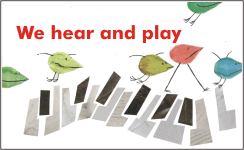
Click to return to the home page
This ear-training method consists of games you will play with your child. You play the games at home, and as you play, your child will learn absolute pitch.
Piano playing is introduced in conjunction with these games. Although this handbook is written for a music teacher, who will guide you in how to practice piano with your child, you can cooperate at home while having only a minimal knowledge of music and musical notation. You do need to know what a chord and an octave are, and you need to know how to play a piano chord. Your instructor will be sure to show these to you. Even if you can’t read music, you will be able to match the note colors along with your child.
When playing the games, it’s essential to ignore your child’s mistakes and praise their successes. The authors discuss the psychological support for this approach on page 31 and in other places in the book.
To begin playing the training games, turn to page 8. Your child’s music teacher will guide you when it is time for your child to begin playing the piano.
To play the training games, you will need
• A well-tuned piano in good condition
• A stool for your child’s feet
• One or more sets of seven small balls in red, blue, yellow, orange, brown, grey, and green
• Colored self-adhesive dots (¾ inch) in these same seven colors
• We Hear and Play, Volume OneTo learn more about the Taneda method, its goals and philosophy, read the Preface and Foreword on page 1.
To learn more about absolute pitch, turn to page 76.
For answers to frequently asked questions, turn to page 78.
This book is designed to be a practical guide. You can start right away by
• Reviewing the materials you’ll need (page 4)
• Familiarizing yourself with the method’s four games (page 8)
• Studying the suggested first lesson (page 22)When playing the games, it’s essential to ignore the child’s mistakes, and to praise their efforts as well as their successes. The authors discuss the psychological support for this approach on page 31 and in other places in the book.
As you approach the piano, you will want to familiarize yourself with the principles of piano technique in small children (page 24), the theory and application of using colored notes (page 59), and the philosophy of training preschool children (page 31). Step-by-step guidance for the We Hear and Play piano books begins on page 34.
To learn more about the Taneda method, its goals and philosophy, read the Preface and Foreword on page 1.
To learn more about absolute pitch, turn to page 76.
For answers to frequently asked questions, turn to page 78.
Advanced training concepts start on page 58.
Preface by Christopher Aruffo
Foreword by Naoyuki and Ruth Taneda
Frequently Asked Questions about Absolute Pitch
Introducing Traditional Notation, part 1